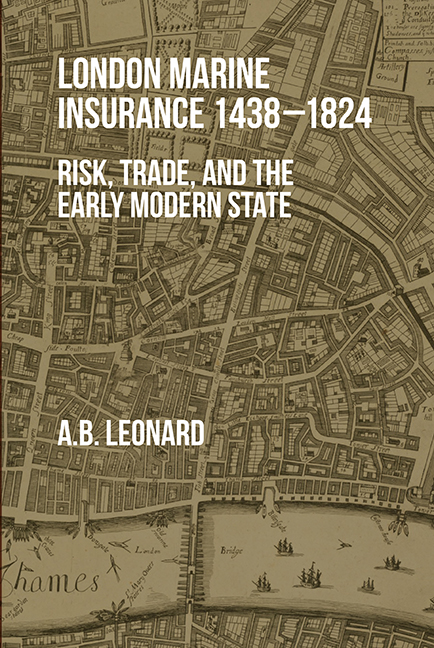Book contents
- Frontmatter
- Contents
- List of Illustrations
- Preface
- Glossary of marine insurance terms
- Introduction
- 1 The merchant-insurers’ system: London marine insurance to the 1570s
- 2 1570–1688: Buyers and the first intervention
- 3 1688–1720: The sellers’ intervention
- 4 To 1824: Lloyd’s and the common law
- 5 Conclusions
- Appendix: Some London underwriters active 1690–1717
- Bibliography
- Index
4 - To 1824: Lloyd’s and the common law
Published online by Cambridge University Press: 26 May 2022
- Frontmatter
- Contents
- List of Illustrations
- Preface
- Glossary of marine insurance terms
- Introduction
- 1 The merchant-insurers’ system: London marine insurance to the 1570s
- 2 1570–1688: Buyers and the first intervention
- 3 1688–1720: The sellers’ intervention
- 4 To 1824: Lloyd’s and the common law
- 5 Conclusions
- Appendix: Some London underwriters active 1690–1717
- Bibliography
- Index
Summary
The effect of the second intervention
The Royal Exchange Assurance and the London Assurance had the potential to change the structure of the London insurance market beyond recognition. This did not happen; their marine insurance business did not flourish. The new companies did well at the outset: John Williams, deputy governor of the future Royal, told the Hungerford Committee that the insurer, in its first nine months of operation, had insured ships and goods to the value of £1,259,604. In 1810, a pamphleteer identifying himself only as a subscriber to Lloyd's estimated credibly, based on this figure, that both companies together had underwritten a tenth of the country's marine insurance. Eight merchants sent a petition to the committee stating that ‘they had assured their Adventures at Sea, to a considerable Value, with [the Royal], some of which having been Losses or Averages, [were] Adjusted and paid… according to their Contract, without Delay, to entire Satisfaction’. Further, Sir Justus Beck certified that he and ‘several other Merchants of London… have for this present Year received very considerable Commissions from Merchants in Foreign Parts, to make Assurances in London’, and that those orders were to be filled with the companies.
Still, the companies’ immediate fortunes were not good. Both ‘had invested largely in South Sea Stock’, and ‘had sustained a heavy loss on twelve Jamaica ships’. These bad investments caused their share prices to collapse. They were unable to meet the payments owed to the government under the conditions of their charters, and sought relief. Further subscriptions, which would have raised their nominal capital (if not their paid-up capital) beyond the limits specified in their charters, were halted by government intervention. They did not make significant additional calls upon their existing shareholders to increase their paid-up capital; presumably this constituency was reeling under other Bubble-era losses. In order to survive, both companies sought, and were granted, charters to underwrite fire and life assurance.In the words of Wright and Fayle, ‘the companies’ difficulty was the [private] underwriters’ opportunity’. Thereafter the companies were unable ever to obtain a position of significance in London's marine insurance marketplace (although both remained active in this class of insurance, as do their descendants).
- Type
- Chapter
- Information
- London Marine Insurance 1438-1824Risk, Trade, and the Early Modern State, pp. 161 - 211Publisher: Boydell & BrewerPrint publication year: 2022

